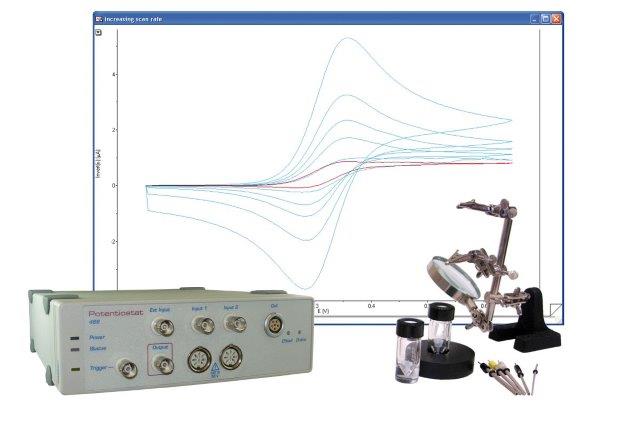Electrochemistry


Many electrochemical experiments can be performed using an e-corder with Chart, Scope, EChem or PowerChrom software. In addition we offer several models of potentiostat:
- ER467 High Current Potentiostat
- ER466 Integrated Potentiostat
- EA163 Potentiostat
- EA362 Dual Picostat (high sensitivity bipotentiostat for use with microelectrodes)
- EA164 QuadStat (four-channel potentiostat)
However, many other brands and models of potentiostat are also compatible with e-corder.
 Need equipment?
Need equipment?See the EChem Startup System a complete system with software, data recording unit, potentiostat and electrodes, which is ideal for those wanting to include voltammetric experiments in their undergraduate course, or for researchers who want a system for cyclic voltammetry. Also see our range of electrodes.
Common techniques are:
-
Amperometry
Sometimes called chronoamperometry, or constant potential recording.
A fixed potential is held at the working electrode and the current flow monitored with time. Chart software is typically used to record results. With Chart you can also use the Computed Function Integral to integrate the signal over to perform coulometric recording. -
Differential Pulse Amperometry
A fixed potential is held at the working electrode for most of the time, except for voltage pulses which are applied at regular intervals. The current flow is monitored just prior to, and also during the pulse. The current flow measured immediately prior to the pulse is subtracted from the current measured during the pulse. These current differences versus time are plotted. This has the effect of removing 'baseline drift'. The EChem MultiPulse Amperometry technique is designed for this type of experiment. -
Differential Pulse Voltammetry
A gradually increasing (or decreasing) potential is applied at the electrode by incrementing the potential in small steps. At the end of each step a voltage pulse is applied. The current flow is measured just before, and again during the pulse. The resulting difference between these two current flows are plotted versus the potential of the step. The occurrence of a signal peak at a particular potential gives an indication of the type of substance present while the peak height (or peak area) gives a quantitative measure of the concentration. Use the EChem Differential Pulse Voltammtery technique for this type of experiment. -
Cyclic Voltammetry
A gradually increasing (or decreasing) potential is applied at the electrode by incrementing the potential in small steps. When the maximum (or minimum) desired potential is reached the direction of the 'sweep' is reversed. The current flow is measured at each step (usually at the end of the step). The current flow is plotted versus the potential of the step. The occurrence of a signal peak at a particular potential gives an indication of the type of substance present. While peak height gives an indication of concentration the method is usually not used for accurate quantitative determinations. Use the EChem Cyclic Voltammtery technique (up to about 500 V/s) this type of experiment.
Most other voltammetric techniques are available using e-corder with the EChem software.
More Information
DISCLAIMER: The appearance of a third party company or product on this page is for informational purposes and constitutes neither a recommendation nor an endorsement.



